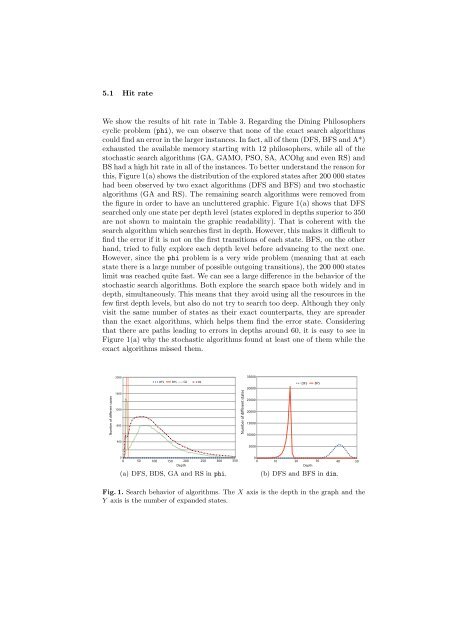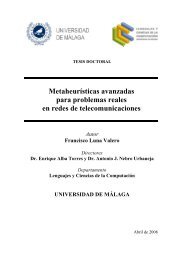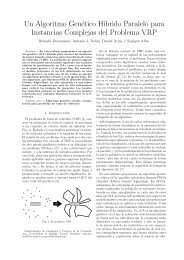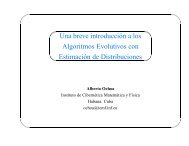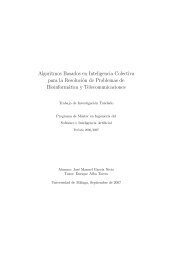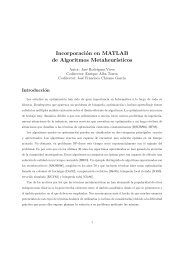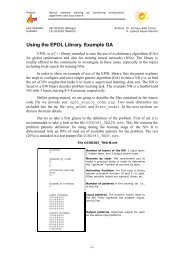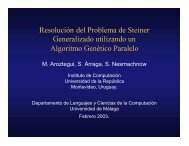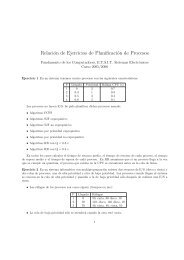Comparing Metaheuristic Algorithms for Error Detection in ... - NEO
Comparing Metaheuristic Algorithms for Error Detection in ... - NEO
Comparing Metaheuristic Algorithms for Error Detection in ... - NEO
Create successful ePaper yourself
Turn your PDF publications into a flip-book with our unique Google optimized e-Paper software.
5.1 Hit rate<br />
We show the results of hit rate <strong>in</strong> Table 3. Regard<strong>in</strong>g the D<strong>in</strong><strong>in</strong>g Philosophers<br />
cyclic problem (phi), we can observe that none of the exact search algorithms<br />
could f<strong>in</strong>d an error <strong>in</strong> the larger <strong>in</strong>stances. In fact, all of them (DFS, BFS and A*)<br />
exhausted the available memory start<strong>in</strong>g with 12 philosophers, while all of the<br />
stochastic search algorithms (GA, GAMO, PSO, SA, ACOhg and even RS) and<br />
BS had a high hit rate <strong>in</strong> all of the <strong>in</strong>stances. To better understand the reason <strong>for</strong><br />
this, Figure 1(a) shows the distribution of the explored states after 200 000 states<br />
had been observed by two exact algorithms (DFS and BFS) and two stochastic<br />
algorithms (GA and RS). The rema<strong>in</strong><strong>in</strong>g search algorithms were removed from<br />
the figure <strong>in</strong> order to have an uncluttered graphic. Figure 1(a) shows that DFS<br />
searched only one state per depth level (states explored <strong>in</strong> depths superior to 350<br />
are not shown to ma<strong>in</strong>ta<strong>in</strong> the graphic readability). That is coherent with the<br />
search algorithm which searches first <strong>in</strong> depth. However, this makes it difficult to<br />
f<strong>in</strong>d the error if it is not on the first transitions of each state. BFS, on the other<br />
hand, tried to fully explore each depth level be<strong>for</strong>e advanc<strong>in</strong>g to the next one.<br />
However, s<strong>in</strong>ce the phi problem is a very wide problem (mean<strong>in</strong>g that at each<br />
state there is a large number of possible outgo<strong>in</strong>g transitions), the 200 000 states<br />
limit was reached quite fast. We can see a large difference <strong>in</strong> the behavior of the<br />
stochastic search algorithms. Both explore the search space both widely and <strong>in</strong><br />
depth, simultaneously. This means that they avoid us<strong>in</strong>g all the resources <strong>in</strong> the<br />
few first depth levels, but also do not try to search too deep. Although they only<br />
visit the same number of states as their exact counterparts, they are spreader<br />
than the exact algorithms, which helps them f<strong>in</strong>d the error state. Consider<strong>in</strong>g<br />
that there are paths lead<strong>in</strong>g to errors <strong>in</strong> depths around 60, it is easy to see <strong>in</strong><br />
Figure 1(a) why the stochastic algorithms found at least one of them while the<br />
exact algorithms missed them.<br />
Number of dierent states<br />
2000<br />
1600<br />
1200<br />
800<br />
400<br />
0<br />
0<br />
DFS BFS GA RS<br />
50 100 150 200<br />
Depth<br />
250 300 350<br />
(a) DFS, BDS, GA and RS <strong>in</strong> phi.<br />
Number of dierent states<br />
35000<br />
30000<br />
25000<br />
20000<br />
15000<br />
10000<br />
5000<br />
DFS BFS<br />
0 0 10 20 30 40 50<br />
Depth<br />
(b) DFS and BFS <strong>in</strong> d<strong>in</strong>.<br />
Fig.1. Search behavior of algorithms. The X axis is the depth <strong>in</strong> the graph and the<br />
Y axis is the number of expanded states.


